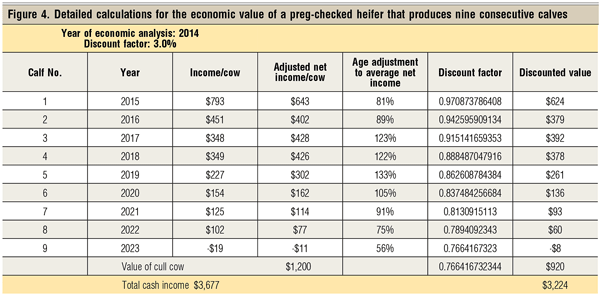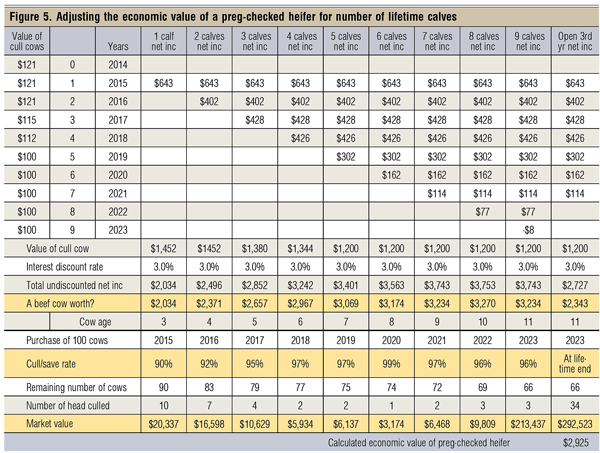What’s the value of a bred beef heifer in 2015?

This month, I’ll focus on projecting the economic value of a preg-checked heifer in the current price cycle. Specifically, we’ll focus on a 2013-born crossbred heifer, bred in 2014 and scheduled to have her first calf in spring 2015.
The most difficult aspect of this task is arriving at a set of planning prices that cover that heifer’s lifetime. A key question is, will the regular cattle cycle return? I suggest that it will “sort of” come back.
In formulating my long-term planning prices, I monitor two data sets. One is USDA’s baseline prices; the other is the long-run price projections by the Food and Policy Resource Institute at the University of Missouri. I use these long-run forecasts as my base to build my own hybrid set of long-run planning prices. It is with tongue in cheek that I share these planning prices.
The prices shown in Figure 1 (2006-2014) are my calculated historical prices for eastern Wyoming-western Nebraska. The planning prices for 2015-2021 suggest that fall-weaned calf prices may have peaked in 2014 (I project a slight increase in slaughter cattle prices from 2015 to 2017). Extremely wide buy/sell margins for cattle feeders and an increasing number of calves born are projected to reduce feeder-calf prices slowly over the rest of this decade.

The net-present-value procedure used to project the economic value of a preg-checked heifer uses the annual net cash flow of the herd being studied. To keep things simple, I’m assuming that this study herd has no beef-cow debt. The debt on my study operation is on the farming side.
Figure 2 presents the calculated 2014 net cash flow per cow on my Wyoming-Nebraska study herd. With a calculated net cash flow of $791 per cow (before family living draw), 2014 was a record year for this debt-free herd.
 This annual net cash flow for replacement heifers will need to be adjusted annually, based on:
This annual net cash flow for replacement heifers will need to be adjusted annually, based on:
• projected calf prices for each year
• projected inflation in the annual cost of production
• the projected net family living draw against the new females in the herd
Using my study herd’s actual 2014 accounting data (Figure 2) as the base, I’ve projected the net cash flow per cow for 2015-2023. I assumed a family living draw of $100 per cow from the added females, as well as 2% annual inflation in cash production costs. Again, no debt capital was added for these new cows.
Figure 3 summarizes these annual net cash-flow projections. The combination of slightly lower planning prices and increasing production costs leads to projected lower net annual cash flows per cow as we progress through the decade.
The annual net cash flows from these added females (Figure 3) will be used to calculate the current economic value of a fall 2014 preg-checked heifer. Figure 4 shows the results of this calculation, with the top section presenting the year the heifer was checked pregnant (2014); the discount rate used to determine the time value of a dollar (3%), albeit record-low; and the option of a straight-bred or crossbred heifer. The crossbred option was selected.


The first column of Figure 4 is the calf number from that female, the second column is the calendar year, and the third column is the projected net cash income per female. Meanwhile, the fourth column is adjusted net income based on the adjustment factors in the fifth column, the fifth column is the assumed age adjustment for a female, the sixth column is the annual discount factor, and the last column is the discounted annual net cash income generated by that female.
The left-hand bottom line is the lifetime projected “nominal” net cash income from this female: $3,677 in this example. The bottom-line number on the right is the total “discounted” net cash income after adjusting for the time value of money. In this example, the projected economic value of a crossbred preg-checked heifer is $3,234.
Unfortunately, not all preg-checked heifers will produce nine calves in their lifetime, so we must adjust for this biological factor. To make this lifetime adjustment clearer, let’s assume my study herd manager purchased 100 preg-checked heifers in year 1 (bottom section of Figure 5). The reality is that some of these 100 heifers will be culled each and every year of the planned nine calf crops.

Figure 5 presents the detailed culling projections for these females producing one calf and then being culled, two calves and then being culled, and on through having nine calves before being culled. The final right-hand column presents a special calculation for a female that fails to breed back as a 3-year old, but then goes on to have seven more consecutive calves.
Figure 5’s bottom section adjusts for the fact that not all 100 heifers will have nine calves. We begin with the 100 preg-checked heifers originally purchased. Of those, 10 are open at the end of the first year and will be culled, leaving 90 heifers going into the second year. Total net cash income in year 1 is projected to be $20,337.
This continues each of the nine years in the lifetime of the heifers. Note the drop in annual net cash flow as this example progresses through the decade.
By the end of nine years, only 66 of the original 100 heifers are to still be in the herd. At the end of the ninth calving year, all remaining females will be sold as cull cows.
After accounting for the sale of all live calves produced and the sale of all cull females during the nine-year period, the discounted net cash flow generated is projected at $2,925 per preg-checked heifer. All this leads me to predict that the economic value of a crossbred heifer born in spring 2013, bred in 2014, and calving in the spring of 2015 is $2,925. This is a record number.
With this background laid out, next month, we’ll look at the impact of different biological and economic assumptions behind this projected $2,925 economic value of a bred heifer.
Harlan Hughes is a North Dakota State University professor emeritus. He lives in Kuna, Idaho. Reach him at 701-238-9607 or [email protected].
You might also like:
70 photos honor the hardworking cowboys on the ranch
7 U.S. cattle operations honored for stewardship efforts
How Schiefelbein Farms made room on the ranch for nine sons
Prevention and treatment of cow prolapse
Photo Gallery: Home is where you hang your hat
About the Author(s)
You May Also Like




.png?width=300&auto=webp&quality=80&disable=upscale)
